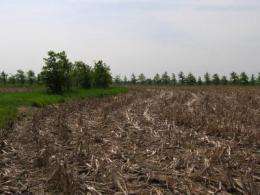Plant buffers may limit spread of antibiotics in animal waste

Research by scientists at the University of Missouri Center for Agroforestry suggests that buffer strips of grasses and other plants can trap and break down veterinary antibiotics in manure fertilizers.
Buffer strips have already demonstrated that they can be effective in protecting water quality, controlling erosion and supporting wildlife around crop fields.
"That's the beauty of it," said Keith Goyne, assistant professor of environmental soil chemistry in the MU School of Natural Resources. "Vegetative buffers already are a recommended practice for reducing sediment, nutrients and herbicides in surface runoff. Our research is showing another benefit."
The finding comes amid emerging concerns about the use of veterinary antibiotics in livestock farming. Thirty to 80 percent of any given dose of antibiotic may end up excreted as waste rather than absorbed by the animal, Goyne said. When manure is used to fertilize croplands, antibiotics in the manure-enriched soil may leave the farm via surface runoff and eventually end up in streams, lakes or rivers.
While the concentrations of the antibiotics appear to be too small to pose a direct threat to human health, scientists worry that the presence of these compounds in soil and water may foster the emergence of drug-resistant bacteria that could infect wildlife, livestock and people. The compounds also may harm ecosystems by disrupting communities of soil microbes, which play a crucial role in cycling nutrients and decomposing organic matter.
Earlier studies by MU scientists have shown that grass buffers in croplands can filter herbicides in surface runoff by physically trapping sediment and nurturing microorganisms that break down herbicides.
Goyne and colleagues—including assistant professor of forestry Chung-Ho Lin, professor of soil science Steven Anderson, graduate student Bei Chu, and two USDA soil scientists based at MU, Robert Lerch and Robert Kremer—have been conducting laboratory and field tests to see if buffers could play a similar role in filtering antibiotics.
In one study, the researchers collected soil samples from both croplands and grass and agroforestry buffers at three MU research farms in Missouri—the Horticulture and Agroforestry Research Center in New Franklin, Southwest Center in Mount Vernon, and the Greenley Research Center in Novelty. They exposed the samples to two common veterinary antibiotics, sulfadimethoxine and oxytetracycline.
Comparisons of soil from croplands and buffers revealed that soils from several types of plant buffers were effective at reducing concentrations of the antibiotics.
A report on the research appeared recently in the journal Agroforestry Systems.
Related projects include a study at MU's Bradford Farm near Columbia that looks at the effectiveness of three different buffer designs in reducing antibiotics in surface runoff.
The overall goal is to determine which combinations of plant species and soil types are most effective at filtering and degrading antibiotics, Goyne said.
Provided by University of Missouri-Columbia

















